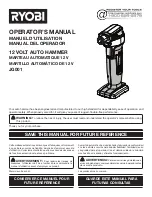
002AZ001A
8 - 45
MAINTENANCE
8
8.1.2.9.9
Cleaning control valve Pb
- Unscrew the control valve (21).
- Loosen the screws (20) and lift up the block.
- Remove the part (30) by hand.
- Clean the regulator, block and part using compressed air.
- Carry out the operations in reverse order to put the parts back in place.
8.1.2.9.10 Cleaning control valve Ph
- Unscrew the control valve (22).
- Loosen the screws (19) and lift up the block.
- Remove the part (29) by hand.
- Clean the regulator, block and part using compressed air.
- Carry out the operations in reverse order to put the parts back in place.
8.1.2.9.11 Cleaning solenoid control valves Pb and Ph
- Before attempting to perform these operations, write down how the valve is directed as its position cannot be
changed when re-installed.
- Loosen the screws (23).
- Remove the solenoid valve.
- Divide bodies (16 and 17).
- Remove the cylinder (18) and thoroughly clean.
- Carry out the operations in reverse order to put the parts back in place. Be careful not to change the direction of the
valve.
8.1.2.9.12 Checking for condensate on the bottom of the tank
- See if there is any condensate on the bottom of the hydraulic power unit tank. If condensate is found, dry the damp
parts with a rag.
8.1.2.9.13 Checking the accumulator precharge
- Make sure there is no pressure in the hydraulic circuit.
- Unscrew the cap found on the side where the inflation valve (38) is installed.
- Unscrew the regulator (39).
- Open the bleeder (40).
- Screw the inflation tester found on the inflation valve manually.
- Secure the connector manually positioning the pressure gauge as required.
- Screw the regulator (39) observing the pressure gauge’s needle. When the needle moves from 0 continue turning
(1/2 a turn is enough; there is no need to fully tighten).
- Read the inflation pressure given on the gauge (to check the values, consult the DATA SHEET).
• To reduce the pressure.
-
Slowly open the bleeder (40) until the desired pressure is reached.
• To increase the pressure.
-
Take off the knurled cap (41).
-
Attach the end of the hose (1/4" BSO at 60
°
) to connector (42).
-
Attach the other end of the hose to the nitrogen source and pressurize (it is fundamental to wait until heat
exchanging caused by the pressures has stabilized before checking or precharging).
E0035P
E0034D
O
2
WARNING!
Only use dry nitrogen, in cylinders provided with a pressure reducer, in order to pre-charge the accumulators.
Never, under any circumstances, use air compressors and/or oxygen.
- To disassemble carry out the operations in reverse order.
- Make sure the inflator valve on the accumulator is well sealed.
- Screw the cap on the inflator valve side.
Summary of Contents for CCM001
Page 2: ...002AZ001A 0 2 TABLE OF CONTENTS...
Page 4: ...002AZ001A 0 4 TABLE OF CONTENTS...
Page 10: ...002AZ001A 0 10 TABLE OF CONTENTS...
Page 14: ...002AZ001A 1 4 1 GENERAL INFORMATION T2525 1 8 MACHINE IDENTIFICATION PLATE...
Page 50: ...002AZ001A 2 36 2 MACHINE FEATURES...
Page 106: ...002AZ001A 7 20 7 ADJUSTMENTS...
Page 119: ...002AZ001A 8 13 MAINTENANCE 8 T2575 Figure 8 1 2 2 50 kg h EXTRUDER 6 31 33 32 7 8 1 3 17 5...
Page 162: ...002AZ001A 8 56 8 MAINTENANCE...
Page 164: ...002AZ001A 9 2 9 DECOMMISSIONING...














































